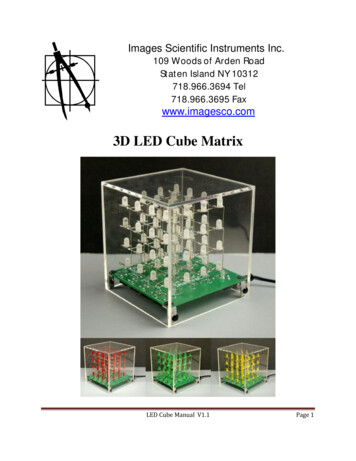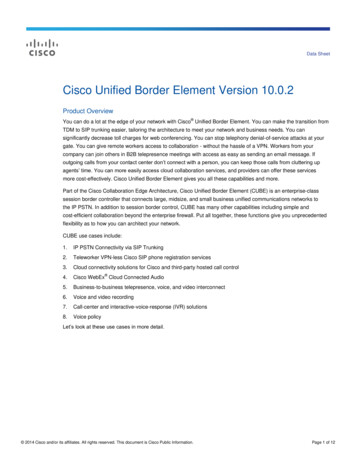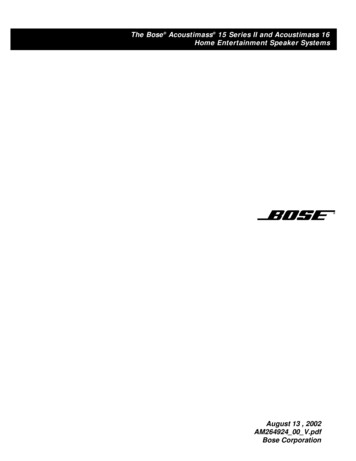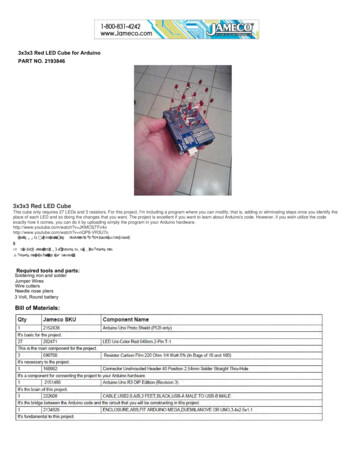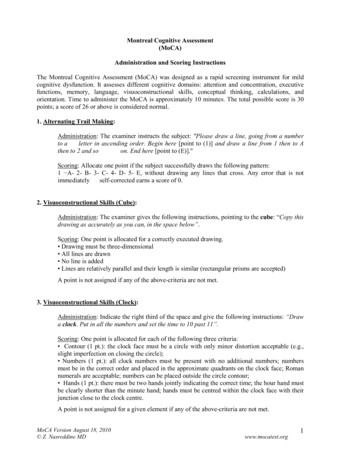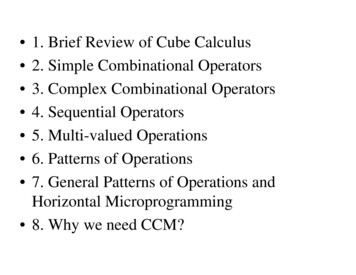
Transcription
1. Brief Review of Cube Calculus2. Simple Combinational Operators3. Complex Combinational Operators4. Sequential Operators5. Multi-valued Operations6. Patterns of Operations7. General Patterns of Operations andHorizontal Microprogramming 8. Why we need CCM?
Cube Calculusfor CCM
Overview Of This Lecture A Brief Review of Cube Calculus. Summary of Cube Calculus operations. Positional notation concept for CubeCalculus operations. Summary of Positional notation concept forCube Calculus operations. Why we need a Cube Calculus Machine?
Brief ReviewOf CubeCalculus
Representation of cubes in(Binary logic) For the function f(a,b,c,d) A B a’bc’ ac’d we have two cubes (a’bc’and ac’d) Cube is a Product ofliterals. In binary logic, they can be representedas A a{0} .b{1} .c{0} .d{0,1} andB a{1} .b{0,1} .c{0} .d{1}
General Representation ofcubes in (n valued logic) A x1s1A. x2s2A xnsnA B x1s1B. x2s2B .xnsnB where x1s1A .xnsnA.,x1s1B, . xnsnB are literals. n is the number of variables. siA, siB are true sets of literal xi . An example of a ternary logic is:A x1{0}. x2{0,2}. x3{1}. x4{1,2}B x1{1}. x2{1}. x3{2} . x4{0,1}
CubeCalculusOperations
Cube Calculus OperationsThe cube calculus operations are classified as : Simple Combinational operations (e.g. Intersection,SuperCube ). Complex Combinational operations (e.g. Prime,Consensus, Cofactor). Sequential operations (e.g. Crosslink, Sharp(non-disjoint),Sharp (disjoint)). Let us discuss these operations.
SimpleCombinationalCubeOperations
Simple Combinational Operations Defined as a SINGLE set operationon all pairs of true sets andproduces one resultant cube. Intersection and Supercube aresimple combinational cubeoperations.
Example OfBinaryFunction
Kmap representation ofIntersection B ab A bc’ Set theory :B ab abx a{1}b{1}c{0,1} A bc’ xbc’ a{0,1}b{1}c{0} B A a{1} {0,1}b{1} {1}c{0,1} {0} abc’
Kmap representation ofIntersectionA x2*xA3B x1*xB2 Fig 1: Input Cubes Aand B to beIntersected. Here– A x2*x3– B x1*x2x1*x2 *x3 Fig 2:Resultant CubeC A B x1*x2 *x3
Kmap representation ofSupercube A and B has 3variables.B bc’A ab B bc’ In set theory A abxB xbc’ A B b
K-map representation ofSuper cube Input Cubes A and Bto be supercubed.A x1’x2’x4B x1x3x4C A B x4A x1’x2’x4B x1x3x4 Resultant CubeC A B x4
Examples OfMulti-ValuedFunctions
K-map representation ofSupercubeSupercube For 4 valued inputlogic. Input Cubes A and Bto be supercubed.A a01b1. B a12b2 Resultant CubeC A B a012b12
K-map representation ofIntersection For 4 valued inputlogic. Input Cubes A and Bfor Intersection.A a12b12. B a2b012 Resultant CubeC A B a2b12
Definitions ofSimpleCombinationalCube Operations
Intersection of two cubes :Is the largest cube thatis included in both A and B.Supercube of two cubes :Is the smallest cubethat includes both cubes.
Simple Combinational Operation Intersection operation mathematically isdefined asA s BA s BssA B x1 1 1 xn n n if siA siB otherwise. Union operation mathematically is defined asA s BA s BssA B x1 1 1 xn n n
ComplexCombinationalCubeOperations
Complex combinationalcube operations They have two set operations and one set relation. All variables whose pair of true sets satisfy a relation are said tobe SpecialVariables. Two set operations are called before(bef) and active(act),theactive set operation is applied on true sets of special variables andbefore set operation to others All Combinational cube operations (Complex and Simple)produce one resultant cube, all special variables taken at a time. The examples are prime operation, cofactor operation,consensus operation.
Examples ofComplexCombinationalCube Operations
Example OfBinary Function
Example of consensus operation A & B have 4 binaryvariables– A x1x2x3’– B x1x2’ Steps: find the set relationsiA siB . If satisfied then it is a specialvariable. Active operation (siA siB)applied to special variables. And to remaining variables(before variables) the setoperator siA siB is applied
Explanation ofconsensusoperation In set theoryA x1{1}x2{1}x3{0}x4{0,1}B x1{1}x2{0}x3{0,1}x4{0,1} Applying the set relation siA siB on all the true set of variables x1 is a special variable and to x1 active operation (siA siB) isapplied and to x2 ,x3 ,x4 before set operator (siA siB ) is applied A * B x1{1} x3{0} x1x3’
Example of prime operationprime A&B has 4binary variablesA x1’x2x3x4B x1x3’Step 1:1 Find intersectionoperation(set relation) onall true sets(siA siB ) Step 2:2 If the set relation issatisfied apply active setoperation(siA siB ) elsebefore set operation( siA ).
Explanation of theExample Using set theoryB x1{1} x2{0,1}x3{0}x4{0,1}A x1{0}x2{1}x3{1}x4{1}Step 1. Find if set relation (siA siB ) is satisfied or not x2 and x4 are special variables.Step 2. As the given set relation is satisfied.for thevariables x2 and x4 to these variables active set operation(siA siB ) is applied and to the others (x1 , x3 ) before setoperation ( siA ) is applied A’B x1{0}x3{1} x1’x3.
Example of cofactor operation A and B have 4 binaryvariables.This is cofactor of cube A with respect to cube B(variable x1)– A x1x2x3– B x1 Steps: Find siA siB(If satisfied specialvariable) Apply U(Universal set(0,1))for special variablesandsiA siB for others
ExplanationSet theory:A x1{1}x2{1}x3{1}x4{0,1}B x1{1}x2{0,1}x3{0,1}x4{0,1} Testing the relation siA siB for the variables. x1 and x4 arespecial variables. Universal set operator applied to thesevariables. To the rest of the variables the intersection operation is applied. The result is x2 x3. In K-map apply the intersection operator and remove the special variables.
Example OfMulti-ValuedFunction
K-map representation of ConsensusAB A X 01234 Y01 B X012 Y23 A*B X 01234Y01*X012Y23 X012 Y0123
Definitions ofComplexCombinationalCube Operations
General Descriptionof Consensus CubeOperation
Complex combinational cubeoperation The consensus operation on cubes A and B is defined asA B when distance (A,B) 0A*B when distance (A,B) 1A *basic B when distance (A,B) 1 where A *basic B BA s1BA sk-1BAsks1sk-1skx1 .xk-1xk A sk 1BA snBsk 1snxk 1 xn. Set relation: siA siB , if satisfied, a special variable Active set operation : siA siB Before set operation : siA siB
Complex combinationalcube operation Applications of consensus operator:– For finding prime implicants (Used for twolevel logic minimization),– three level,– multilevel minimization,– and machine learning.
GeneralDescription ofCofactor CubeOperation
Complex combinational cubeoperationCofactor operation of two cubes A and B isA B A basic B when A B otherwise Set relation for cofactor operation siA siBActive set operator U (Universal set(0,1))Before set operator siA siB Application: Used in functional decomposition.
reviewApplications ofCrosslink
And we all know that the answer is that we arelooking for two cubes as shown down here,so that our function is to be expressed in the ESOPform as follows: f E!D
GeneralDescription ofPrimeOperation
Complex combinational cubeoperations Prime operation of two cubes A and B is defined ass1A xsk-1Ax skA skBxsk 1A .x snAk-1kk 1nrelation : siA siB is applied to trueA’B x1where setif satisfied active set operation is appliedelse before set operation is applied. Active set operation(act):siA siB Before set operation(bef): siA Application: Used in ESOP minimization .sets and
SequentialCubeOperations
Sequential cube operations They have three set operations and one set relation. All variables whose pair of true sets satisfy a relation are said tobe SpecialVariables. Three set operations are called before(bef),active(act) andafter(aft) The active set operation is applied on true sets of special variable The before set operation to variables before the special variable The after set operation to variables after the special variable. Every special variable is taken once at a time.
Sequential cube operations All sequentialcube operationsproduce ‘n’resultant cubes, wheren is the number of special variables. The examples are:sharp operation,–cross link operation.–
Examples ofSequentialCubeOperations
Example OfBinary Function
Let us consider the following example, wherethe relation operation is SA SB ϕ
Cubes A and B are of 4 variablesLet us consider the following two cubes,Cube A x1 x2 x3’ x1{1}*x2{1}*x3{0} *x4{0,1}Cube B x1 x2’ x1{1}*x2{0}*x3{0,1} *x4{0,1}
These two variables (x1 and x3) are the so calledspecial variables , and we find them out by checkingthe relation between every literal in both cubes for arelation which is for the crosslink ( is the intersectionbetween these two variables is empty?).Cube ACube Bx1{0}x2{0,1} x1{1}x2{0,1}x3{0} x4{0,1} x3{1} x4{0,1}We can see that the intersection is empty for only X1 and X3therefore they are special variables.variables
Example of crosslinkoperation A and B has 4 binaryvariables. A x1’x3’ x1{0}x2{0,1}x3{0}x4{0,1 B x1x3 x1{1}x2{0,1}x3{1}x4{0,1} A c B x1’x3’ x1x3 x3’ x1
Example Cubes :x1{0}x2{0,1} x3{0}x4{0,1}x1{1}x2{0,1}x3{1} x4{0,1}Set Relation: siA siB ϕ x1 and x3 are special variables. Act: siA siB, Bef: siA, Aft: siB x1{0} {1}x2{0,1} x3{0}x4{0,1} andx1 {1}x2{0,1} x3{0} {1} x4{0,1} Two resultant cubes one for each specialvariable. A B x3’ x1
Complex crosslink example A,B,C,D are 4cubes F A B C D F A B E F F G H
Example ofnondisjointsharp A and B has 4 binaryvariables. A x3’ x1{0,1}x2{0,1}x3{0}x4{0,1} B x2x4 x1{0,1}x2{1}x3{0,1}x4{1} Set relation: (siA siB)– 1.x1{0,1} x2{0,1}n( {1}} x3{0}x4{0,1}Act: siA siB, Bef: siA, Aft:siA– 2. x1{0,1}x2{0,1} x3{0} x4{0,1}n( {1}}Act: siA siB, Bef: siA,Aft: siA A # B x2’x3’ x3 ’x4’
Example ofdisjoint sharp A and B has 4 binary variables. A x3’ x1{0,1}x2{0,1}x3{0}x4{0,1} B x2x4 x1{0,1}x2{1}x3{0,1}x4{1}Set relation: (siA siB)x1{0,1}n{0,1}x2{0,1}n( {1}}x3{0}x4{0,1} Act: siA ( siB),Bef: siA, Aft: siA siBx1{0,1}n{0,1}x2{0,1}n{1}x3{0}n{0,1} x4 {0,1}n( {1}}Act: siA ( siB), Bef: siA,Aft: siA siB A #d B x2’x3’ x2x3 ’x4’
Example OfMulti-ValuedFunctions
Example of crosslink operation Let A x0y1 andB x3y3crosslink X and Y arespecial variables. x{0}U {3} y1 and x {3} y{1} {3} Resultant cubes:x03y1 x3y13
Definitions ofSequential CubeOperations
General Descriptionof Nondisjoint sharpOperation
Sequential cube operations. The nondisjoint sharp operation on cubes A and BA#B Awhen A B when A B A #basic B otherwises1A xsk-1Ax skA ( skB)xsk 1A .x snA fork-1kk 1n A #basic B x1such that k 1, .n for which the set relation is true. Set relation: (siA siB).Active set operation: siA ( siB),After set operation: siA,Before set operation: siA Used in tautology problem.
GeneralDescription ofdisjoint sharpoperation
Sequential cube operations. The disjoint sharp operation on cubes A and BA#dB Awhen A B when A B A #dbasic B otherwiseAA skA ( skB)AAs1sk-1sk 1snx1 xk-1xkxk 1 .xn A #dbasic B for such that k 1, .n for which the set relation is true. Set relation: (siA siB)Active set operation: siA ( siB),After set operation: siA siB ,Before set operation: siA Used in tautology problem, conversions between SOPand ESOP representations
General Descriptionof CrosslinkOperation
Sequential cube operations. Generalized equation of Crosslink operation:BB skA skBAAs1sk-1sk 1snx1 xk-1xkxk 1 .xnA B where k 1, .n for which the set relation is true. Set relation:relation siA siB ,Active set operation : siA siB,After set operation : siB,Before set operation : siA.Used in the minimization of logic function onEXOR logic, Generalized Reed-Muller form.
So the solution is to find these two cubes out (Cubes E, D).Let us see how the crosslink operation does that!!!Here is the K map for the original function againHere if we think about it, we are looking for literals, in which theintersection of these literals in both cubes is empty, that isX1 and X3,Because in the firstcube we have
Summaryof theCube CalculusOperations
Summary of cubecalculus operations
PositionalNotation
Positional notation Cube operations were broken into several set relations andset operations. Easy to carry out by hand. To Process set operations efficiently by computers, weuse positional notation. Positional notation : Possible value of a variable is 0 or 1. P valued variable a string of p bit Positional notation of binary literals:x’ x{0} x10 10 x x{1} x01 01, don’t care x x{0,1} x11 11, contradiction x{ } x00 00
Set operations in positionalnotation Three basic set operations are executed using bit wise operationsin positional notation. Set intersection bitwise AND Example A ab B bc’A B abc’ In positional notation: A 01-01-11 B 11-01-10A B (01/11)-(01/01)-(11/10) 01-01-10(abc’) Set union bitwise OR Example A ab B bc’A B b In positional notation: A 01-01-11 B 11-01-10A B (01/11)-(01/01)-(11/10) 11-01-11(b)
Positional notationSet complement operation bitwise NOTExample: A ab then A’ (ab)’In positional notation: A 01-01 A’ 10-10Example of multi valued variable:A x{0,1,2} B x{0,2,3}A B {0,2}, A B {0,1,2,3} In positional notation: A 1110, B 1011 A B 1110/1011 1010{0,2},A B 1110/1011 1111{0,1,2,3}A’ 0001{3}, B’ 0100{1}
Set relations in positionalnotation 1 True and 0 False Set relation cannot be done by bit wise operation as it is afunction of all bits of operands. Set relation is broken into Partial relation and Relation type. The partial relation determine whether or not the two literalssatisfy the relation locally. The relation type determines the method of combining partialrelations. Relation(A,B) (a0’ b0’).(a1’ b1’) (an’-1 bn’-1) forcrosslink operation Partial relation ai’ bi’and relation type isAND.
Table of partial relation
Summary of cube operationsin positional notation
Why We Need aCube CalculusMachine?
Why Using Cube Calculus Machine? The cube calculus Operations can beimplemented on general-purpose computers, But in general-purpose computers, the control islocated in the program that is stored in thememory. This results in a considerable control overhead.overhead Since the instructions have to be fetched from thememory, if an algorithm contains loops, the sameinstruction will be read many times.
Why Using Cube Calculus Machine?That makes the memory interface thebottleneck of these architectures.The cube calculus operations involvenested loops, it leads to poorperformance on these general-purposecomputers.
SourcesNouraddin AlhagiSyeda MohsinaQihong Chen
special variables. Universal set operator applied to these variables. To the rest of the variables the intersection operation is applied. The result is x2 x3. In K-map apply the intersection operator and remove the special variables. Set theory: A x1{1}x 2 {1}x 3 {1}x 4 {0,1} B x1{1}x 2 {0,1}x 3 {0,1}x 4 {0,1}

